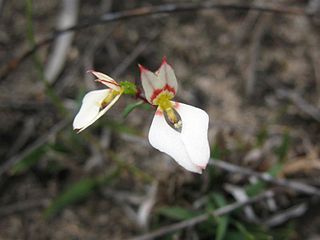
Stylidium is a genus of dicotyledonous plants that belong to the family Stylidiaceae. The genus name Stylidium is derived from the Greek στύλος or stylos, which refers to the distinctive reproductive structure that its flowers possess. Pollination is achieved through the use of the sensitive "trigger", which comprises the male and female reproductive organs fused into a floral column that snaps forward quickly in response to touch, harmlessly covering the insect in pollen. Most of the approximately 300 species are only found in Australia, making it the fifth largest genus in that country. Triggerplants are considered to be protocarnivorous or carnivorous because the glandular trichomes that cover the scape and flower can trap, kill, and digest small insects with protease enzymes produced by the plant. Recent research has raised questions as to the status of protocarnivory within Stylidium.

Stylidium laricifolium, commonly known as giant trigger-plant, larch-leaf or tree triggerplant, or is a species of flowering plant in the family Stylidiaceae and is endemic to eastern Australia. It is a perennial subshrub with many linear leaves crowded along its few stems, the flowers white to pale pink and arranged in a single main panicle and smaller racemes.
Juliet Ann Wege is an Australian botanist. She graduated in 1992 and gained a PhD at The University of Western Australia in 1999 with a thesis titled "Morphological and anatomical variation within Stylidium (Stylidiaceae): a systematic perspective". As of 2021 she works as a researcher at the Western Australian Herbarium run by Western Australia's Department of Biodiversity, Conservation and Attractions and is managing editor of Nuytsia. Her main area of expertise is in taxonomy and study of the Stylidiaceae family of triggerplants.
Allen Lowrie was a Western Australian botanist. He was recognised for his expertise on the genera Drosera and Stylidium.

Stylidium tenerum, the swamp triggerplant, is a dicotyledonous plant that belongs to the genus Stylidium that was described by Curt Polycarp Joachim Sprengel in 1826. Robert Brown had described this species in 1810 under the name S. tenellum, a name which had already been used for another species in 1805 by Olof Swartz. To add to the confusion, Rica Erickson had described and illustrated this taxon in 1958 under the name S. uliginosum, another currently accepted name for a related species.

Levenhookia pauciflora, the deceptive stylewort, is a dicotyledonous plant that belongs to the genus Levenhookia. It is an ephemeral annual that grows from 5–10 centimetres (2.0–3.9 in) tall with ovate to suborbicular leaves. Flowers are white and bloom from September to November in its native range. L. pauciflora is endemic to Western Australia where it grows in sandy soils in sandstone or granitic areas. The flowers of L. pauciflora resemble those of Stylidium ecorne and it has been said that S. ecorne mimics L. pauciflora to take advantage of its pollinators.

Stylidium perpusillum, the tiny triggerplant, is a dicotyledonous plant that belongs to the genus Stylidium, that occurs in south west Western Australia.
Stylidium inaequipetalum, the Ayers Rock triggerplant, is a small herbaceous perennial plant in the genus Stylidium. It grows from 7 to 40 cm tall. Oblanceolate leaves, about 20-100 per plant, form a basal rosette with stems absent. The leaves are generally 15–81 mm long and 2–8 mm wide. This species produces 1-11 scapes per plant. Inflorescences are 7–40 cm long and produce pink flowers with petals all free and blooms almost year-round in their native range. S. inaequipetalum is endemic to the southwestern Northern Territory and Western Australia. Its typical habitat has been reported as sandy soils on sheltered creekbanks or in between rocks. S. inaequipetalum is most closely related to S. floribundum, though it is also closely allied with S. debile.

Galium divaricatum is a species of flowering plant in the coffee family known by the common name Lamarck's bedstraw.

Stylidium rupestre is a dicotyledonous plant that belongs to the genus Stylidium, a species sometimes named as the rock triggerplant. It is found in Southwest Australia. The species was first described by Otto Wilhelm Sonder.

Stylidium spathulatum is a dicotyledonous plant that belongs to the genus Stylidium. The species is informally named the creamy triggerplant for the colour of its flowers.

Stylidium affine is a species in the genus Stylidium that is endemic to Western Australia.

Ribes divaricatum is a species in the genus Ribes found in the forests, woodlands, and coastal scrub of western North America from British Columbia to California. The three accepted varieties have various common names which include the word "gooseberry". Other common names include coast black gooseberry, wild gooseberry, Worcesterberry, or spreading-branched gooseberry.

Sherwin John Carlquist FMLS was an American botanist and photographer.

Stylidium humphreysii is a species of trigger plant endemic to desert regions of Western Australia. American botanist Sherwin Carlquist named the species after West Australian amateur botanist Fred Humphreys.
Alexander Clifford "Cliff" Beauglehole was an Australian farmer, botanist, plant collector and naturalist.
Marco Duretto is a manager and senior research scientist at the Royal Botanic Gardens Sydney in Australia.
Malcolm Eric Trudgen is a West Australian botanist. He has published some 105 botanical names. He currently runs his own consulting company, ME Trudgen and Associates.

Symphyotrichum divaricatum is an annual and herbaceous plant commonly known as southern annual saltmarsh aster. It is native to the southern United States and some northern states of Mexico.













